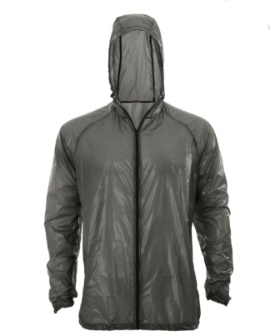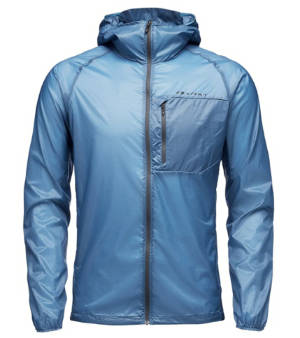
Windbreakers and wind shirts are ultralight lightweight jackets, running shells, pullovers, or anoraks weighing 2 to 8 ounces, that hikers and backpackers wear as a barrier to prevent winds from stripping away their body heat. They’re usually made of highly breathable and thin (low denier) nylon that can be worn over a fleece or base layer to block the wind and keep you warmer when hiking or trail running. They’re amazingly warm considering how lightweight they are.
Here are the best windbreakers and wind shirts and shells available today. Note: when shopping for windbreakers, and wind shells, retailers may list them under trail running jackets or running jackets, since there’s so much overlap with hiking and backpacking.
| Make / Model | Fabric Denier | Weight |
|---|---|---|
| Arcteryx Squamish Hoodie | 30d | 4.9 oz / 140g |
| Patagonia Houdini Jacket | 15d | 3.7 oz /105g |
| Enlightened Equipment Copperfield Wind Shirt | 10d | 2.05 oz / 58g |
| Rab Vital Windshell Hoody | 20d | 4.6 oz /160g |
| REI Flash Jacket | NA | 4.3 oz /122g |
| Outdoor Research Helium Wind Hoodie | 30d | 5.3 oz /150g |
| Black Diamond Distance Wind Shell | 15d | 3.5 oz / 98g |
| Warbonnet Stash Jacket | 20d | 5.0 oz / 142g |
| Montbell Tachyon Hooded Jacket | 7d | 2.5 oz / 72g |
| Black Diamond Alpine Start Hoody | 20d | 7.4 oz /210g |
While you can wear a windbreaker anywhere, they’re particularly useful when wearing a rain jacket or technical shell will be too warm. Wind shirts are a great layer to wear on cold mornings over a fleece because they hold your body heat without the bulk of a rain jacket. Elastic wrist cuffs, an adjustable waist hem, and a full-length zipper are also useful for sealing in the heat and venting for thermal regulation.
1. Arc’teryx Squamish Hoody Windshell
| Shop at REI | Shop at Amazon |
2. Patagonia Houdini Jacket
3. Enlightened Equipment Copperfield Wind Shirt
4. Rab Vital Hoody
5. REI Flash Jacket
6. Outdoor Research Helium Wind Jacket
7. Black Diamond Distance Wind Shell
8. Warbonnet Stash Jacket
9. Montbell Tachyon Parka
10. Black Diamond Alpine Start Hoody
Windbreaker and Wind Shirt Buyers Guide
Here are the key features and factors to be on the lookout for when choosing a windbreaker or wind shirt.
Wind Resistance
The wind resistance of a windbreaker depends on how tightly the fabric it’s made with is woven and features that help seal the jacket from drafts like elastic wrist cuffs, a drawcord hem, and a fully adjustable hood. Most windbreakers and wind shirts are made from thin, low-denier nylon or polyester that is highly breathable as well as being windproof. Some windbreakers are cut slim which is good for running, while others are more generously sized so you can wear them over a mid-layer, which is often desirable for hiking, backpacking, climbing, and mountaineering.
Breathability and Venting
Unlike rain jackets, nylon windbreakers, and wind shells usually have quite good breathability right through the fabric, which you can verify when you feel the fabric becoming damp under your armpits from perspiration. In general, the thinner the fabric weight, measured in terms of denier, the better it will be from a breathability standpoint. Keep in mind that very thin fabrics wear out much more quickly than thicker more durable ones. Some jackets also use more specialized nylon that has a very tight weave for improved wind resistance, even though this can mean they retain more heat. If heat buildup is a concern, it’s better to get a wind jacket with a full-length zipper instead of relying on underarm vents for additional ventilation. Foregoing a hood is also another strategy that can reduce a wind jacket’s level of heat retention.
Weight and Packability
Wind shells typically range in weight from 1.5 oz up to 6 oz and are highly packable, usually compressing down to the size of an apple because they’re made with such lightweight nylon. When hiking and backpacking, it’s often convenient to stuff a wind shirt or wind jacket loosely in your backpack, filling in the voids between stuff sacks and gear, rather than scrunching it up or stuffing it into its chest pocket, unless you want to attach it to a climbing harness.
Water Resistance
Most windbreakers and wind shells have a DWR coating on the exterior to repel mist and drizzle, but you shouldn’t count on a wind jacket to keep you dry in the rain. The DWR coating will also quickly wear off the more times you stuff the jacket into a backpack or into a pocket, rendering it useless. If you need a rain jacket, buy yourself a proper rain jacket designed for that task. Similarly, most rain jackets are too warm to use as windbreakers.
Wind Jackets vs Pullovers
Windbreakers are available as jackets with full-length front zippers or pullovers with quarter-length or half-length chest zips. Full zip jackets are usually preferable in terms of ventilation because they allow more airflow, but pullovers are usually lighter because they forego the added zipper weight or are hoodless.
Hood Adjustability
An adjustable hood is important to seal out drafts, particularly around the face. Look for jackets with neck toggles and barring that, ones with tightly fitting elasticated face openings. A rear volume adjuster is also beneficial to downsize a hood to a human-friendly size if it’s helmet-compatible.
Fabric Denier
Fabric denier is a unit of measurement used to determine the fiber thickness of individual threads used in the creation of fabrics. Fabrics with a high denier count tend to be thick, sturdy, durable, and heavier. Fabrics with a low denier count tend to be sheer, soft, silky, and lighter in weight.
Venting
While venting, as in pit zips is helpful, it’s just not as effective as a full-length zipper. Because weight is at such a premium on wind shirts, if there are pit zips, they’ll be permanently open rather than having zippers.
SectionHiker is reader-supported. We only make money if you purchase a product through our affiliate links. Help us continue to test and write unsponsored and independent gear reviews, beginner FAQs, and free hiking guides. SectionHiker.com Backpacking Gear Reviews and FAQs
SectionHiker.com Backpacking Gear Reviews and FAQs 









I’ve had the Montbell Tachyon for about 3 years now and love it. Tough little shell for the weight.
My oldish OR hybrid windshirt (hood and shoulders waterproofed) is my most valued piece of kit. The hard part is figuring out breathabilty of the fabric. Denier only gives a hint, as there are several ways to finish a fabric, some less breathable rhan others. In various tests, the Montbell and EE Copperfield usually prove most breathable. Popular Pata Houdini is in the middle. I sweat a lot so I want more airflow. The Warbonnet impresses with the side zips. Wish there was some standardized way of measuring breathability. In the mean time, buy something with a good return policy so you wind up with the amount of breathability you want.
I call my old Houdini my 3.0 because I cut off the things I didn’t need like labels and hem cinch. My new one is even lighter as they simplified the hood cinch. I love this as a mid layer barrier in the winter so I can switch my top heavy layers without losing heat.
Enlightened equip copperfield has made tough spot in my ‘must carry’ kit for both day hiking and backpacking. One of my best gear investments so far – held up in OR blowdown early season without a rip and have carried / worn it since April and 1000+ OR miles. Recommend it. – goat bells (GoatBells.blog)
I’ve had one for a couple of years. The fabric is so wispy I’m convinced it’s going to shred at the slightest insult, but like you said mine’s proven more durable than I expected. It goes in my pack on every hike.
I own a Rab Vital, it’s a basic jacket but very good. My son bought it for me as a Christmas present. I think the hood is a bit wacky in design but that’s my only whinge about it. It does the job. I also own a wind jacket from Decathlon, (£14, 2 years ago) it’s just as good and has a better hood as well.
For the money, you can’t beat the NOLS windshirt.
Curious about how sizing runs in normal people sizes. I have both the Squamish and the Helium in XXL. I can fit my Cerium puffy under the Squamish, but not much more than a thin midlayer under the Helium.
Different manufacturers…hard to say.